Millennium Project
Clifton Past and Present- LE Gardner
His extensive account (pdf) of Clifton's history was written in 1955
Clifton - Jackie Williamson
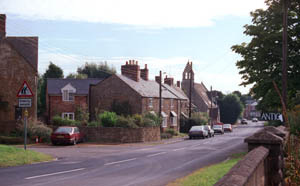 It is easy to imagine Clifton as it was 60 years ago. The thatch is long gone, replaced by low maintenance slate and tile; the growl of diesel-driven 4x4s has taken over from the clip-clop of horses hooves and instead of the clatter of iron cartwheels the muted roar of the motorway floats in the air when the wind blows from the east. But you can still sit quietly in the long grass beside Bowman's Brook and picture the drover passing through with his sheep on his way to Somerton, and the low lying meadows are still transformed into mirrored lakes every autumn, just as they have been for thousands of years.
It is easy to imagine Clifton as it was 60 years ago. The thatch is long gone, replaced by low maintenance slate and tile; the growl of diesel-driven 4x4s has taken over from the clip-clop of horses hooves and instead of the clatter of iron cartwheels the muted roar of the motorway floats in the air when the wind blows from the east. But you can still sit quietly in the long grass beside Bowman's Brook and picture the drover passing through with his sheep on his way to Somerton, and the low lying meadows are still transformed into mirrored lakes every autumn, just as they have been for thousands of years.
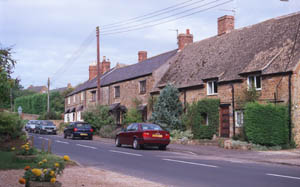 Clifton is a sleepy hamlet of 75 houses and a pub on the eastern boundary of the parish of Deddington. The river Cherwell marks the parish boundary as well as the boundary between Oxfordshire and Northamptonshire. The M40 is within sight and sound of Clifton, with the nearest junction about five miles away at Ardley. The nearest main railway stations are Banbury about 10 miles to the north, or Bicester 10 miles to the east, with a halt at Kings Sutton four miles away. The towpath of the Oxford canal, with its brightly painted, traditional narrow boats, is a popular walk just half a mile away, across the fields.
Clifton is a sleepy hamlet of 75 houses and a pub on the eastern boundary of the parish of Deddington. The river Cherwell marks the parish boundary as well as the boundary between Oxfordshire and Northamptonshire. The M40 is within sight and sound of Clifton, with the nearest junction about five miles away at Ardley. The nearest main railway stations are Banbury about 10 miles to the north, or Bicester 10 miles to the east, with a halt at Kings Sutton four miles away. The towpath of the Oxford canal, with its brightly painted, traditional narrow boats, is a popular walk just half a mile away, across the fields.
A few Cliftonians have lived in the village all their lives but these days most of the people who live there are relative newcomers, attracted to the village by the peace and beauty of the countryside while earning their living elsewhere. The only businesses today are a couple of family farms, a home for frail, elderly people and a handful of small companies operating from the converted St James's Church.
But it wasn't always so. Sixty years ago, before the war, Clifton was a thriving agricultural community with seven working farms each employing up to three local people as well as supporting their own families. Traditional crops were grown in the fields and most farms also kept a mix of dairy cows, beef cattle, sheep, pigs and chickens. Local smallholders had a few chains of land each and harvested and threshed their own corn. They kept a few chickens and grew potatoes for themselves and their pig, which would be fattened up in the yard and end up on the table. The miller, George Robinson of Clifton Mill, ground corn for the farmers which they then used to feed their stock in the winter. Others made their living on the canal and the railway attracted many workers from the village.
As well as the farms there was a village school (which closed in 1945), shop and post office, and Frank Garratt of Home Farm delivered milk straight from the cow to all the houses. Other self-employed tradesmen included Ramsey Sykes, a well-known hedge layer and ditch digger, a wheelwright and Teddy Mobbs, a blacksmith from Aynho who travelled regularly to the forge at Ashley House in Chapel Close to shoe all the village horses - in those days there was only one car. There are still traces of these slower, pastoral times. Peep into the big Dutch barns behind The Chestnuts and you will see two farm carts under their shroud of dust and cobwebs, still proudly bearing the Welford family name.
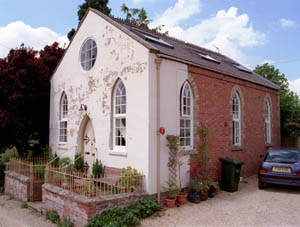
These days the faithful have to travel to Deddington or further afield to worship, but 60 years ago St James's Church on the main road was very active and even had its own choir. Consecrated on 10th June 1852 it celebrated its jubilee in June 1903 with a sit-down tea for 146 people! There was also a Methodist Chapel in Chapel Close which was converted into a charming three bed-roomed home several years ago.
Ed's note:c.f. Pevsner's Building of England description
The size of the population and number of homes in Clifton has not changed much in 60 years, although some of the old houses have been replaced with new ones. At the turn of the 20th century 302 people lived in the village and there were around 70 houses. These days, most of the residents own their homes but before the war most of the agricultural workers lived in tied cottages and the railway workers rented theirs. There was much more thatch around in those days too. The house at Clifton Mill, owned by the Welford family, was thatched, as were many of the farmworkers' cottages which have now been demolished.
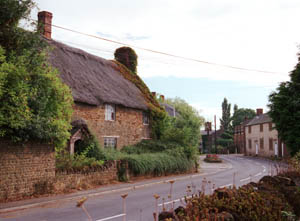 While
residents of Clifton take running water and modern sanitation for
granted, there is still no gas in the village. Sixty years ago 10 or 12
houses had their own wells and the rest of the locals had to draw their
water from a spring at the mill or from stand-pipes. Most toilets were
outside and emptied after dark by Ramsey Sykes, who smoked a clay pipe
while he did it! His odorous task was eventually taken over by the
council who used to send a horse-drawn tanker to collect the 'night
soil'.
While
residents of Clifton take running water and modern sanitation for
granted, there is still no gas in the village. Sixty years ago 10 or 12
houses had their own wells and the rest of the locals had to draw their
water from a spring at the mill or from stand-pipes. Most toilets were
outside and emptied after dark by Ramsey Sykes, who smoked a clay pipe
while he did it! His odorous task was eventually taken over by the
council who used to send a horse-drawn tanker to collect the 'night
soil'.
All that's left of those days is the standpipe on the corner of Chapel Close ... and the ghost which, some say, still stalks Pepper Alley, Hartwell Cottage and parts of Walnut Close.
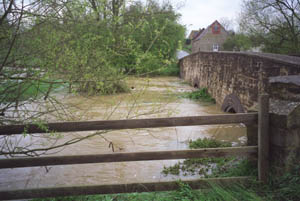 The scenery around Clifton has changed little over the years,
although there used to be more willows along the river and Dutch elm
disease devastated the native elm population in the 1970s. The low-lying
fields to the east still flood the way they always flooded when it
rains, and Easter 1998 brought the most spectacular floods in living
memory. The road was impassable except by tractor and the ground floor
of the mill house was under several inches of water. Donald Welford,
whose grandfather owned Clifton Mill, says neither he nor his
grandfather ever knew the mill to flood before.
The scenery around Clifton has changed little over the years,
although there used to be more willows along the river and Dutch elm
disease devastated the native elm population in the 1970s. The low-lying
fields to the east still flood the way they always flooded when it
rains, and Easter 1998 brought the most spectacular floods in living
memory. The road was impassable except by tractor and the ground floor
of the mill house was under several inches of water. Donald Welford,
whose grandfather owned Clifton Mill, says neither he nor his
grandfather ever knew the mill to flood before.
Clifton is rich in native flora and fauna and even the opening of the motorway on 16th January 1991 has made little difference to the numbers of birds and animals to be seen. Foxes, roe and muntjac deer, badgers, hare and rabbits abound and the bird population attracts twitchers from all over the country. The skies above the meadows fill with the sounds of the skylark during the spring and summer, and visiting waders flock in when the wetlands flood in the late winter and spring. The biggest decline has been in the numbers of otters and water vole and this is linked by many to the increase in minks which have become a pest.
Now, Clifton is a charming and friendly place to live. The old ways may have passed into history but the rural traditions of friendliness and community spirit will undoubtedly continue into the future.
Useful links
Ruth Johnson's DN article 'Be Happy, Be Good, Donald Welfords' Family History'
Clifton map, part of Deddington Map Group's Millennium project
A list of people in Clifton from the Cartwright papers in 1623
Walks round the Parish - some of which include Clifton
Artcile about the artist Joseph Wilkins who painted a Bird's Eye View of Clifton post 1852